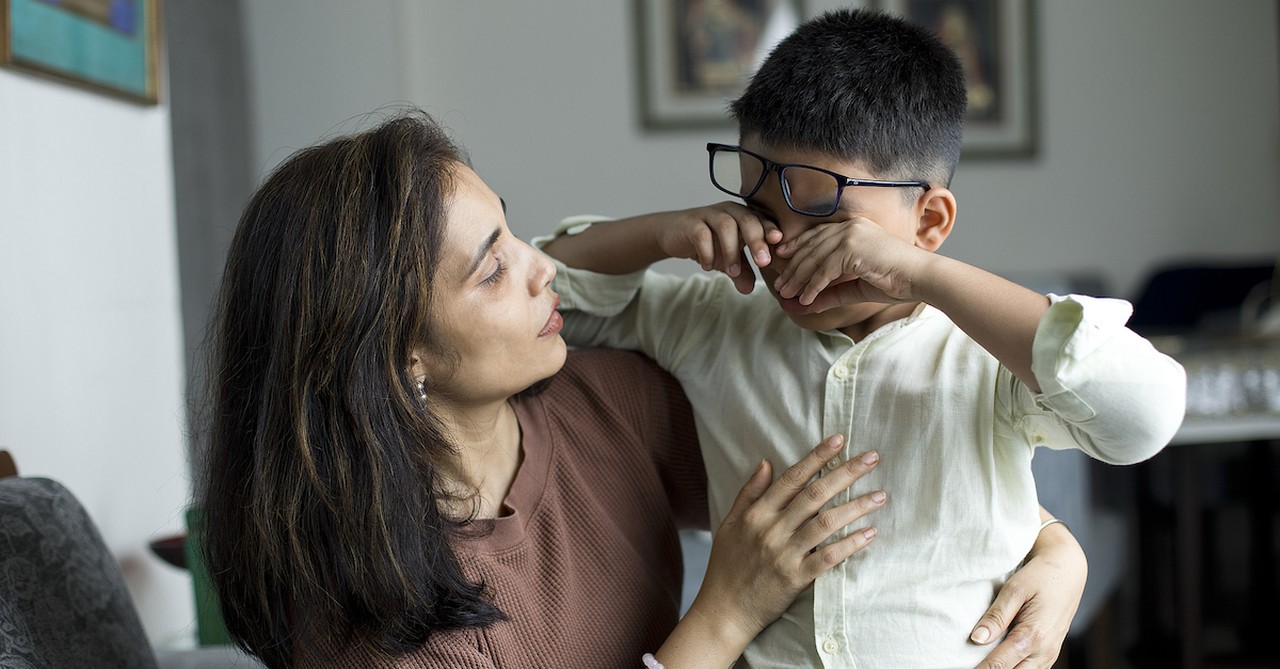4 Ways to Help Your Kids Navigate Big Emotions

Big emotions can be complex for parents to navigate. In my experience, the most challenging part of handling your child's blow-ups is keeping your own big emotional response in check. Staying calm when your child pushes every button they can is no small accomplishment!
In addition to learning to control ourselves, growing our toolkit for understanding our children's behaviors better and de-escalating things when they get out of hand is helpful. Behavior is always trying to communicate something to us. This is true for our kids and ourselves when we are stuck as parents. Taking a step back to consider what is happening in the situation can lead to the breakthroughs we seek. We may need other professionals and support to help our child thrive.
Let's explore some ways to help our kids manage those big, baffling emotions:
1. Engage the Body

1. Engage the Body
SLIDE 1 OF 4
Emotional breakdowns happen when our feeling brain overruns our thinking brain.
One strategy to get the thinking brain back online is to engage the body. One simple trick to try is patting the top of your child's head first. This can sometimes help disrupt their meltdown and bring them back to reality.
Changing scenery can help. When one of our kiddos has been stuck in a meltdown, we've taken him outside, drawn a bath, or brought him to a new space. A new sensory experience can help end the spiral of emotions.
Bear hugs, gentle pulling of the limbs, deep breathing, twisting, walking around, rocking your child, and singing to them are all strategies I've used that help engage the body and calm the nervous system.
When the child is calm, teach them some of these strategies so that when you invite them to take deep breaths in the heat of the moment, it feels familiar to them. We want to empower them with the tools they need to regulate themselves successfully as they grow older.
2. Offer Empathy

2. Offer Empathy
SLIDE 2 OF 4
Kids can't learn how to regulate themselves on their own. That means they need us to show them how to ride some of those dicey emotional roller coasters with them. This is called co-regulation.
The best first step to co-regulation is offering empathy when your child is overwhelmed by circumstances. Acknowledge their feelings and offer them words for their frustration without removing the boundaries you placed to keep them safe.
For example, if your child is upset because they wanted candy and you told them no, you can say, "I see you're very mad. You wanted that candy and are showing me that."
You haven't given them the candy because that teaches them that big behaviors are rewarded, but you are acknowledging and putting words to their feelings. Sitting in the feelings with them, helping them process how they are feeling, putting words to their feelings, and giving them choices on how to move forward are great ways to show them empathy and teach them how to handle those emotions when they hit.
The key is to stay regulated during this process, as the parent or you will most likely worsen matters. Remember, their emotions aren't about you; it's just how they are feeling, and they still need help learning how to handle their minds and bodies better.
For me, I know that I often can't immediately come and sit in the emotions with my child because they trigger me. I frequently give them a place to wait for me or allow them to cry for a few minutes on their own, and then I join them to help address their feelings after taking deep breaths to help calm my body. This pause allows me to be more successful in helping my child get to a calmer place rather than getting more and more upset because we are both stuck in our big, baffling emotions together.
Photo Credit: ©iStock/Getty Images Plus/Inside Creative House
3. Create Predictable Routines and Rhythms

3. Create Predictable Routines and Rhythms
SLIDE 3 OF 4
Kids like to feel safe. Maintaining predictable routines and rhythms in your home is a great way to accomplish this. This does not mean that every day has to be the same, but it does mean that your child can come to anticipate certain events, expectations, and activities in their daily and weekly routines.
Some key times that predictability and clear expectations can help are morning, evening, mealtimes, and transition times. If your child knows how you want them to start their day, when they will eat, where to get the things they need, and how quickly they need to be ready, that can help them start their day with less stress.
If your child anticipates when and how to eat during the day, they will be less cranky and feel safe, as food is a critical need they know will be met.
Transitions can also bring on big emotions. Talk to your child about ways you can help them transition more successfully if they are old enough to have a conversation. Giving younger kids reminders that a transition is coming can help them mentally prepare. Clear and consistent instructions for the transition can keep them calm and on task. Visual cues can support them as they change tasks or checklists. If your child struggles with transitions, brainstorming ahead of time on how to make them easier is a great way to reduce meltdowns.
4. Consider Other Underlying Causes for Big Emotions

4. Consider Other Underlying Causes for Big Emotions
SLIDE 4 OF 4
All humans struggle to manage their emotions, especially kids, but sometimes, there is a more challenging underlying cause for frequent outbursts. If you find that your child struggles throughout the day to stay regulated despite your efforts to soothe and support them, you may need some extra support.
Neurodivergent kids struggle more with emotional regulation, as well as kids who have experienced loss or trauma. For example, one huge struggle for children with ADHD is emotional regulation, but that's not often the first thing you think of when you imagine a person with ADHD. Consulting your pediatrician if you are overwhelmed is a great way to explore what else you could do to support your child.
Play Therapy, Occupational Therapy, regular chiropractic care, specific supplements, diet changes, and more can help give your child more support if it's a little harder for them to keep their nervous system calm. Early intervention is helpful, so lean into your village and find more ways to grow as a family if you feel you are in the weeds. Sometimes, kids grow past those tough seasons, and that's amazing. Other times, they will need more help learning the skills they need to thrive, and it's your job to do all you can to support them on their journey.

Originally published June 23, 2025.









